

The Impact of Green Buildings on Cognitive Function. Overview The indoor built environment plays a critical role in our overall well-being.
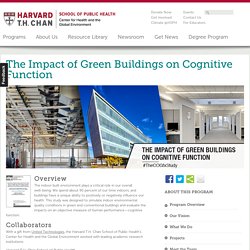
We spend about 90 percent of our time indoors, and buildings have a unique ability to positively or negatively influence our health. This study was designed to simulate indoor environmental quality conditions in green and conventional buildings and evaluate the impacts on an objective measure of human performance—cognitive function. Collaborators With a gift from United Technologies, the Harvard T.H. Harvard T.H. Syracuse University Center of Excellence—The Total Indoor Environmental Quality Laboratory (TIEQ) SUNY Upstate Medical School Study Design Twenty-four participants spent six full work days in an environmentally-controlled office space at the TIEQ lab at the Syracuse Center of Excellence.
Researchers also artificially elevated CO2 levels independent of ventilation. Results On average, cognitive scores were: Fifth Assessment Report - Impacts, Adaptation and Vulnerability. Click to on the link to download the chapter, graphics, authors etc.
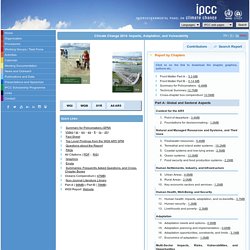
Front Matter Part A - 5.3 MBFront Matter Part B - 0.14 MBSummary for Policymakers - 6.4MB Technical Summary 12.7MB Cross-chapter box compendium 10.5MB Part A: Global and Sectoral Aspects Context for the AR5 Point of departure - 3.4MB Foundations for decisionmaking - 1.0MB Natural and Managed Resources and Systems, and Their Uses. The City and the Coming Climate: Climate Change in the Places We Live. Urban heat island effect. Pale pavement trial Reducing temperatures in urban areas The City of Sydney is trialling a lighter-coloured pavement in Myrtle Street, between Abercrombie and Smithers streets in Chippendale, as part of an investigation into ways of reducing temperatures in urban areas.
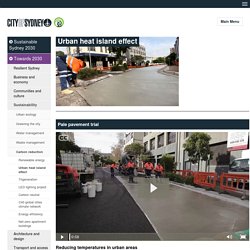
Lighter-coloured surfaces do not generally absorb as much light, or retain as much heat as dark surfaces and therefore have the potential to reduce temperatures, result in lower energy bills for surrounding buildings, and improve road strength. Contacts For more information about the pale pavement trial, please contact: Iraj Shrestha Project Coordinator02 9265 9333ishrestha@cityofsydney.nsw.gov.au Measuring the effect in Sydney The City of Sydney is collecting information to see how shade trees and pavement colour affect urban temperatures.
Children%20in%20the%20outdoors%20literature%20review tcm4 597028. WHO Collaborating Centre for Healthy Urban Environments - UWE Bristol: WHO Collaborating Centre for Healthy Urban Environments. The WHO Collaborating Centre for Healthy Urban Environments promotes healthy and sustainable settlements through research, teaching, consultancy, knowledge exchange and publications.
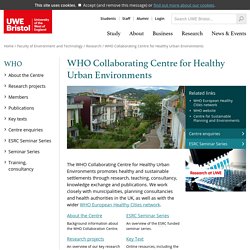
We work closely with municipalities, planning consultancies and health authorities in the UK, as well as with the wider WHO European Healthy Cities network. About the Centre Background information about the WHO Collaboration Centre. Research projects. WHO European Healthy Cities Network. The WHO European Healthy Cities Network consists of cities around the WHO European Region that are committed to health and sustainable development: nearly 100 cities and towns from 30 countries.
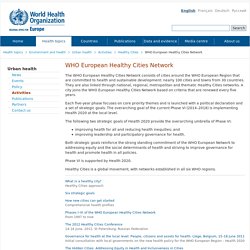
They are also linked through national, regional, metropolitan and thematic Healthy Cities networks. A city joins the WHO European Healthy Cities Network based on criteria that are renewed every five years. Each five-year phase focuses on core priority themes and is launched with a political declaration and a set of strategic goals. The overarching goal of the current Phase VI (2014–2018) is implementing Health 2020 at the local level. Academy of Neuroscience for Architecture. Factoring long-term health impacts into urban development. This ambitious project will quantify current and future health costs and benefits of urban environments, helping to make health impacts a priority in urban development planning.
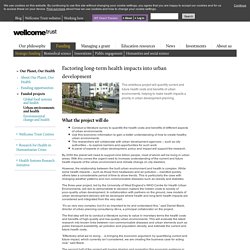
Conduct a literature survey to quantify the health costs and benefits of different aspects of urban environments. Use this economic information to gain a better understanding of how to create healthy urban environments. The researchers will collaborate with urban development agencies – such as city authorities – to explore barriers and opportunities for such work. A panel of experts in urban development, policy and impact will support the research. By 2050 the planet will need to support nine billion people, most of whom will be living in urban areas. Home - Policy Innovation Research Unit. Health and Wellbeing in the Built Environment - Energy, Geoscience, Infrastructure and Society.
Research into health and wellbeing in the built environment addresses the positive and negative effects from people-environment interactions.
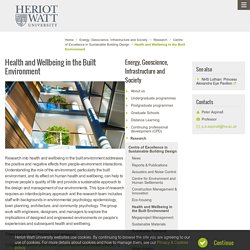
Understanding the role of the environment, particularly the built environment, and its effect on human health and wellbeing, can help to improve people’s quality of life and provide a sustainable approach to the design and management of our environments. This type of research requires an interdisciplinary approach and the research team includes staff with backgrounds in environmental psychology, epidemiology, town planning, architecture, and community psychology. WISE Network – Sustainable Health and Wellbeing. Exploit new business opportunities developed in collaboration with our experts to promote sustainable products that benefit gut health in humans and companion animals using plant extracts and microbial additives to manipulate microbial fermentations and developing screening platforms that combine expertise in microbial ecology and the outcomes of microbial fermentation.

Contact us Theme lead: Jamie Newbold Ruth Fowler With assistance from the WISE Network project South Caernarfon Creameries have used IBERS expertise at Aberystwyth University to enable its milk supplying members to optimize their return for quality milk produced whilst at the same time maximising efficiency in the cheese manufacturing process. Mark Beavon, Operations Director, South Caernarfon Creameries Ltd.